CASE BramWear Lenny Bram owner and manager of BramWear was a
CASE: Bram-Wear Lenny Bram, owner and manager of Bram-Wear, was analyzing performance data for the men’s clothing retailer. He was concerned that inventories were high for certain clothing items, meaning that the company would potentially incur losses due to the need for significant markdowns. At the same time, it had run out of stock for other items early in the season. Some customers appeared frustrated by not finding the items they were looking for and needed to go elsewhere. Lenny knew that the problem, though not yet serious, needed to be addressed immediately. Background Bram-Wear was a retailer that sold clothing catering to young, urban, professional men. It primarily carried upscale, casual attire, as well as a small quantity of outerwear and footwear. Its success did not come from carrying a large product variety, but from a very focused style with an abundance of sizes and colors. Bram-Wear had extremely good financial performance over the past five years. Lenny had attributed the company’s success to a group of excellent buyers. The buyers seemed able to accurately target the style preferences of their customers and correctly forecast product quantities. One challenge was keeping up with customer buying patterns and trends. The Data To determine the source of the problem, Lenny had requested forecast and sales data by product category. Looking at the sheets of data, it appeared that the problem was not with the specific styles or items carried in stock; rather, the problem appeared to be with the quantities ordered by the buyers. Specifically, the problem centered on two items: an athletic shoe called Urban Run and the five-pocket cargo jeans. Urban Run was a popular athletic shoe that had been carried by Bram-Wear for the past four years. Quarterly data for the past four years are shown in the table. The company seemed to always be out of stock of this athletic shoe. The model used by buyers to forecast sales for this item had been seasonal exponential smoothing. Looking at the data, Lenny wondered if this was the best method to use. It seemed to work well in the beginning, but now he was not so sure. The data for the five-pocket cargo jean seemed also to point to a forecasting problem.When the product was introduced last year, it was expected to have a large upward trend. The buyers believed the trend would continue and used an exponential smoothing model with trend to forecast sales. However, they seemed to have too much inventory of this product. As with the Urban Run athletic shoe, Lenny wondered if the right forecasting model was being applied to the data. It seemed he would have to dig out his old operations management text to solve this problem.
CASE: Bram-Wear Lenny Bram, owner and manager of Bram-Wear, was analyzing be with the quantities ordered by the buyers. Specifically, the performance data for the men\'s clothing retailer. He was con problem centered on two items: an athletic shoe called Urban cerned that inventories were high for certain clothing items, Run and the five-pocket cargo jeans. meaning that the company would potentially incur losses due to the need for significant markdowns. At the same time, it had run by Bram-Wear for the past four years. Quarterly data for the past out of stock for other items early in the season. Some customers four years are shown in the table. The company seemed to al- appeared frustrated by not finding the items they were loking ways be out of stock of this athletic shoe. The model used by for and needed to go elsewhere. Lenny knew that the problem, buyers to forecast sales for this item had been seasonal exponen- though not yet serious, needed to be addressed immediately. Urban Run was a popular athletic shoe that had been carried tial smoothing. Looking at the data, Lenny wondered if this was the best method to use. It seemed to work well in the beginning, Background Bram-Wear was a retailer that sold clothing catering to young urban, professional men. It primarily carried upscale, casualto a forecasting problem. When the product was introduced last attire, as well as a small quantity of outerwear and footwear. year, it was expected to have a large upward trend. The buyers Its success did not come from carrying a large product variety, believed the trend would continue and used an exponential but from a very focused style with an abundance of sizes and smoothing model with trend to forecast sales. However, they The data for the five-pocket cargo jean seemed also to point seemed to have too much inventory of this product. As with the Bram-wear had extremely good financial performance over Urban Run athletic shoe, Lenny wondered if the right forecast the past five years. Lenny had attributed the company\'s success ing model was being applied to the data It seemed he would to a group of excellent buyers. The buyers seemed able to accu- have to dig out his old operations management text to solve this rately target the style preferences of their customers and cor- problem. rectly forecast product quantities. One challenge was keeping up with customer buying patterns and trends. Demand for 5-Pocket Cargo Jeans The Data To determine the source of the problem, Lenny had requested forecast and sales data by product category. Looking at the sheets of data, it appeared that the problem was not with the specific styles or items carried in stock: rather, the problem appeared to Year 2 Year 1 Demand Demand Month 101 Demand for Urban Run Athletic Shoe Year 2 Quarter Demand Demand Demand Demand 14 Year 1 Year 4 September 105 15 110Solution
In case of Urban Run seasonal exponential smoothing is being used for forecasting but this has resulted in stock outs.
Exponential smoothing is like time series forecasting. In exponential smoothing, higher weightage is given to more recent data points. The long term accuracy (2 years and above) is poor in case of exponential smoothing. It is more suitable for short term predictions (0-3 months) and medium term predictions.
Here the technique that should be used is \"trend projections\" Trend projections as technique is accurate for short, medium and long term. It will fit a trend line to a mathematical equation and then project the future.
The forecast for 5 pocket cargo jeans uses exponential smoothing model with trend to forecast sales. However this technique is not suitable for long term forecasting as already mentioned. The method that can be used instead is econometric model. This model will do interdependent regression analysis. This technique is very good for short term (0-3 months), medium term (3 months to 2 years) and long term (>2 years).


 Homework Sourse
Homework Sourse